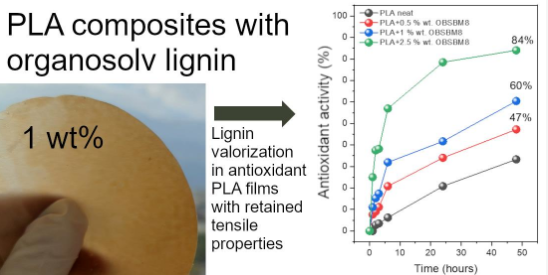


Menu
Triantafyllidis Research Group



23 November 2022
We are very excited to announce a new paper entitled: Synthesis and Characterization of Poly(Lactic Acid) Composites with Organosolv Lignin”, that was published in Molecules, as part of the Special Issue “Synthesis, Properties and Applications of Biobased Polymers”, in collaboration with Prof. Dimitris Bikiaris group who are experts on bio-based PLA polymers. Our group’s contribution was mostly in the production of organosolv lignin and its use as functional filler in PLA.

Abstract
Lignin, being one of the main structural components of lignocellulosic biomass, is considered the most abundant natural source of phenolics and aromatics. Efforts for its valorization were recently explored as it is mostly treated as waste from heat/energy production via combustion. Among them, polymer-based lignin composites are a promising approach to both valorize lignin and to fine tune the properties of polymers. In this work, organosolv lignin, from beech wood, was used as fillers in a poly (lactic acid) (PLA) matrix. The PLA/lignin composites were prepared using melt mixing of masterbatches with neat PLA in three different lignin contents: 0.5, 1.0 and 2.5 wt%. Lignin was used as-isolated, via the organosolv biomass pretreatment/fractionation process and after 8 h of ball milling. The composites were characterized with Scanning Electron Microscopy (SEM), Fourier Transform Infrared Spectroscopy (FTIR) spectroscopy, X-ray Diffraction (XRD), and Differential Scanning Calorimetry (DSC). Additionally, their antioxidant activity was assessed with the 2,2-Diphenyil-1-picrylhydrazyl (DPPH) method, the colour was measured with a colorimeter and the mechanical properties were evaluated with tensile testing. Ball milling, at least under the conditions applied in this study, did not induce a further substantial decrease in the already relatively small organosolv lignin primary particles of ~1 μm. All the produced PLA/lignin composites had a uniform dispersion of lignin. Compression-molded films were successfully prepared, and they were coloured brown, with ball-milled lignin, giving a slightly lighter colour in comparison with the as-received lignin. Hydrogen bonding was detected between the components of the composites, and crystallization of the PLA was suppressed by both lignin, with the suppression being less pronounced by the ball-milled lignin. All composites showed a significantly improved antioxidant activity, and their mechanical properties were maintained for filler content 1 wt%.
You can read the full text here: https://www.mdpi.com/1420-3049/27/23/8143#
